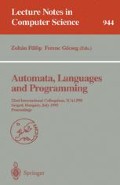Abstract
We have introduced the archer's problem and shown that its solution leads to the intersting class of stage graphs which we characterized to be permutation graphs. The characterization which leads to the solution for the archer's problem allowed for the development of improved algorithms for matching in permutation graphs, for a class of two-processor scheduling problems, and for several geometric problems. We answer the natural question of how the archer's problem generalizes to multiple stages and to three-dimensions. In two dimensions we establish upper and lower bounds on the number of stages required to represent graphs. In three dimensions we give characterization results and establish the NP-completeness of the recognition problem already for triangular stages.
There are several interesting open problems suggested by our investigations. The notion of stage number as a graph theoretic parameter seems to be interesting in its own right. This suggests searching for tighter (constructive or not) upper and lower bounds on the stage number of an arbitrary graph, as well as determining the complexity of the recognition problem G ε \(\mathcal{G}\) k , both for fixed as well as variable k.
Research supported in part by NSERC grant.
Research supported in part by ALMERCO Inc.
Work by the author was carried out during a stay at Carleton University.
The full version of this paper is available on the world wide web address http://www/scs.carleton.ca under technical reports.
Preview
Unable to display preview. Download preview PDF.
References
B. Bollobás, Extremal Graph Theory, Academic Press, 1978.
Coffman, E. G. Jr.; Graham, R. L.; “Optimal scheduling for two-processor systems” Acta Informatica 1 (1972), 200–213.
R. Cole, “Parallel Merge Sort”, SIAM J. Comp. 17:4 (1988), 770–785.
A. Datta, A. Maheshwari, J.-R. Sack, “Optimal parallel algorithms for direct dominance problems”, LNCS 726 (1993), 109–120.
Fujii, M.; Kasami, T.; Ninomiya, K. “Optimal sequencing of two equivalent processors.” SIAM J. Appl. Math. 17:4 (1969), 784–789.
Gabow, H. N. “An almost-linear algorithm for two-processor scheduling” J. ACM 29:3 (1982), 766–780.
Gabow, H. N.; Tarjan, R. E. “A linear-time algorithm for a special case of disjoint set union” J. Comp. and System Sci. 30 (1985), 209–221.
M. T. Goodrich, “Intersecting line segments in parallel with an output-sensitive number of processors”, SIAM J. Comp., 20 (1991), 737–755.
J. JáJá, An introduction to parallel algorithms, Addison-Weseley Publishing Company, 1992.
A. Lingas and A. Maheshwari, “Simple optimal parallel algorithm for reporting paths in trees”, Symposium on Theoretical Aspects of Computer Science, LNCS, 1994.
J. H. van Lint and R. M. Wilson, A Course in Combinatorics, Cambridge University Press, 1992.
L. Lovász, Combinatorial Problems and Exercises, North Holland Publishing Company, 1979.
S. Micali and V. V. Vazirani, “An O(√VE) algorithm for finding maximum matching in general graphs”, in: Proc. 21st Ann. IEEE Symp. Foundations of Computer Science, (1980), 17–27.
Moitra, A.; Johnson, R., C. “A Parallel algorithm for maximum matching on inteivall graphs.” 18th Intl. Conf. on Parallel Processing III (1989), 114–120.
V. Neumann-Lara, “k-Hamiltonian graphs with given girth”, in: Infinite and Finite Sets, Colloquia Mathematica Societatis János Bolyai, Keszthely, Hungary (1973), 1133–1142.
F. P. Preparata and M. I. Shamos, Computational Geometry: An Introduction, Springer-Verlag, New York, 1985.
H. Sachs, Einführung in die Theorie der endlichen Graphen, Teil I–II, Teubner, 1970–1972.
H. Sachs, “Regular graphs with given girth and restricted circuits”, Journal of the London Mathematical Society, 38 (1963), 423–429.
H. Sachs, “On regular graphs with given girth”, in: Theory of Graphs and its Applications, (M. Fiedler, ed.), Academic Press, New York (1965), 91–97.
Sehti, R. “Scheduling graphs on two processors” SIAM J. Comp. 5:1 (1976), 73–82.
J.B. Sidney, S.J. Sidney and J. Urrutia, “Circle Orders, n-gon orders and the crossing number”, Order 5 (1988), 1–10.
J. Spinrad, “On comparability and permutation graphs”, SIAM J. Comp. 14 (1985), 658–670.
J. Urrutia, “Partial orders and Euclidean geometry”. In Algorithms and Order, I. Rival (ed) (1989), 387–434 Kluwer Academic Publishers.
H. Walther and H.-J. Vo\, über Kreise in Graphen, VEB Deutscher Verlag der Wissenschaften, 1974.
H. Warren, “Lower bounds for approximation by nonlinear manifolds”, Transactions of the AMS 133 (1968), 167–178.
M. Yannakakis, “The complexity of the partial order dimension Problem”, SIAM J. Discr. Meth. 3 (1982), 351–358.
Author information
Authors and Affiliations
Editor information
Rights and permissions
Copyright information
© 1995 Springer-Verlag Berlin Heidelberg
About this paper
Cite this paper
Bauernöppel, F. et al. (1995). Optimal shooting: Characterizations and applications. In: Fülöp, Z., Gécseg, F. (eds) Automata, Languages and Programming. ICALP 1995. Lecture Notes in Computer Science, vol 944. Springer, Berlin, Heidelberg. https://doi.org/10.1007/3-540-60084-1_76
Download citation
DOI: https://doi.org/10.1007/3-540-60084-1_76
Published:
Publisher Name: Springer, Berlin, Heidelberg
Print ISBN: 978-3-540-60084-8
Online ISBN: 978-3-540-49425-6
eBook Packages: Springer Book Archive

